To Etosha and Beyond
Text and photos by Eric Schroeder
When I began working with the GGBA Travel Program a year ago, I didn’t envision that one of the benefits might be designing programs that I’d want to go on myself. But when I began to talk with Chris Lotz, who runs Birding Ecotours, one of our GGBA travel partners, I realized that several trips he was proposing appealed to me. Most surprising was one in Namibia and Botswana. I was just getting ready to go to Namibia and I didn’t think I’d want to go back a year later. But Namibia is a special place, and Etosha National Park is one of the great national parks, not just in Africa but worldwide.
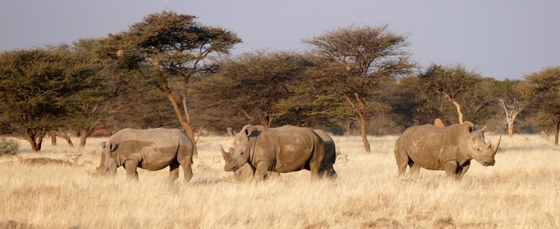
One of the things that I love about Etosha is that you have two different ways to experience the mammals and birds of the park. During the day, you can plan a route in the park that allows you to visit a series of waterholes—if things are slow at one waterhole, then you can move onto another and check for action there. But it can also be rewarding to sit at a waterhole—even if the action seems to have finished (or perhaps hasn’t yet begun!)

My favorite example of this occurred on my first visit to Etosha in 2013. It was late in the afternoon and my wife Susan, friend Ian, and I decided to visit one last waterhole before returning to camp. It proved to be a good decision. When we pulled into the parking area, there were about 20 cars arrayed in an arc around the viewing area. In the middle of a muddy pond two old bull elephants seemed to be fighting. But after closer look, we realized they were actually playing—spraying mud on one another, locking trunks, each determined to make the other even muddier than he already was. An amazing display of what appeared to be affection between two old friends.
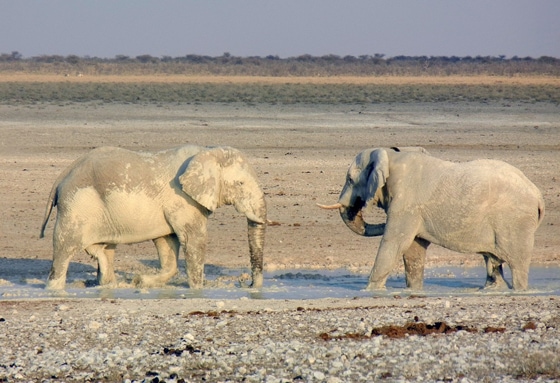
After about fifteen minutes, the elephants seemed to tire of their sport, and each ambled off in a different direction. At that point, almost all the cars in the viewing area started up at once—it was late and the rest camps lock their gates at sundown, and no one wanted to be locked out of camp. But we weren’t very far from camp and, besides, I noticed something out of the corner of my eye as the cars began streaming out—two young male lions trotting towards the waterhole. We suspected that the lions were brothers who had formed a hunting alliance, not an uncommon occurrence.
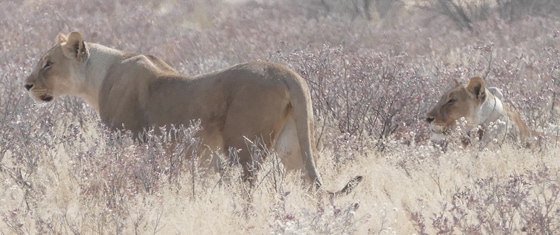
Only two other cars noticed the lions and stayed. The lions came down to the water’s edge for a drink, then they looked into the distance where a small herd of springbok were grazing. We watched one of the lions as he stood scanning the herd. He focused on a particular springbok that appeared to have a slight limp. While his brother slowly circled to the left, the first lion crouched down and began creeping towards the springbok. He accelerated into a trot and then covered the last twenty meters at a sprint. He had picked the right quarry. The springbok barely had time to react. The lion had him on the ground in less than ten seconds from the time he had begun stalking. All of those people who had left when the elephants exited had no idea what they had missed!
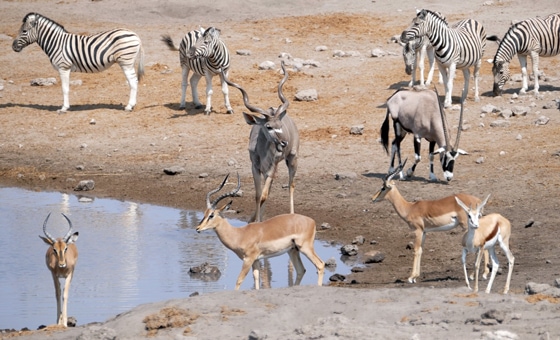
The other way to experience Etosha is to simply stay put in your camp. And since you are literally locked into the camps at night, you sometimes don’t have a choice about this. But staying in the camp can be amazing—after all, Etosha has done an incredible job building its camps around some of the park’s most iconic waterholes.
For instance, the waterhole at Halali Camp is the best place in the park (and perhaps all of Namibia) to see the rare endangered Black Rhino.
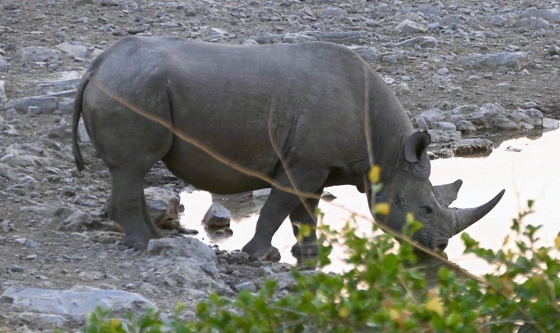
But the big mammals aren’t the only stars of the waterholes—the waterholes also attract a wide variety of birds. My favorite bird encounter occurred last year when I was staying in the Okaukuejo Camp in a room that was very close to the waterhole. I woke up one night at 2 AM and decided I’d go outside and see who was around. No large mammals, but a pair of Barn Owls were circling overhead; they appeared to be hunting bats who in turn were hunting insects over the water. I watched them for about twenty minutes, then went back to bed and slept soundly.

Namibia, which is primarily desert, generally presents a landscape of browns and greys. And many of the birds reflect this palate, and even seem to mimic it. For instance, this seems particularly true of the bustards and korhaans.
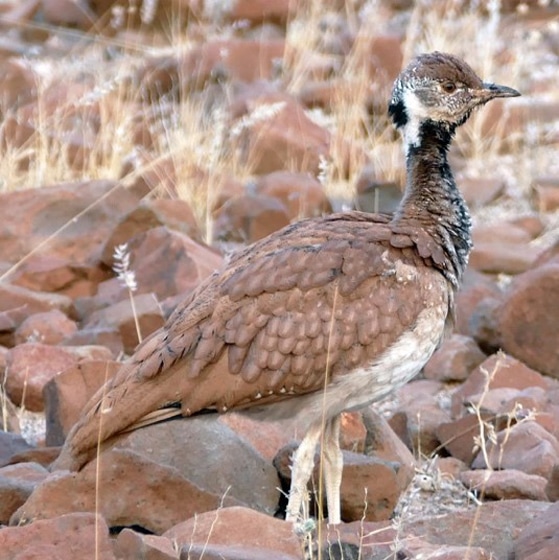
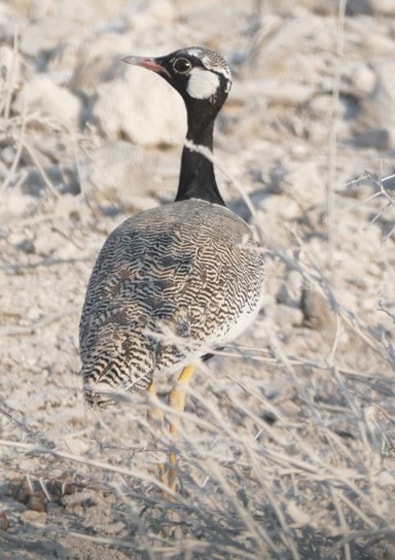
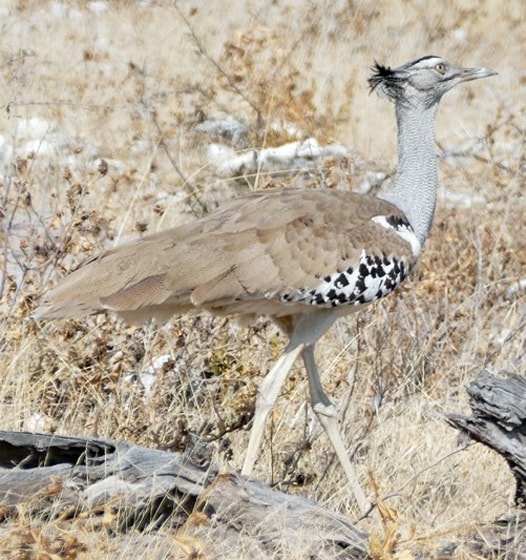
But one of the things that I love the most about Etosha are the birds that repudiate camouflage.
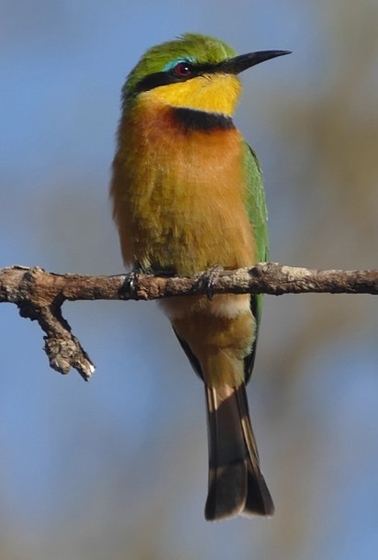
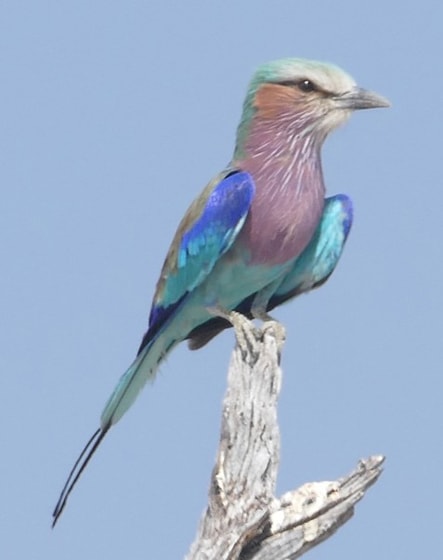

And sometimes, you don’t even have to look for the birds; they find you!
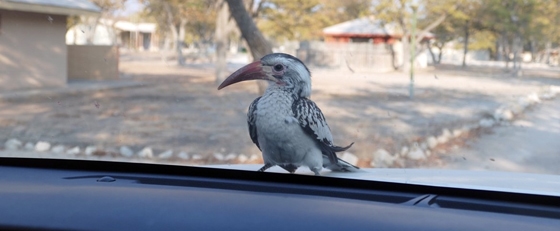
According to eBird, Namibia has 626 species of birds, including lots of camouflaged species and plenty of colorful ones. In addition to the desert habitat of Etosha National Park, Namibia has other habitats with interesting residents. That’s one of the reasons why I’m so eager to return and visit new places. For instance, our first stop on the GGBA tour will be Walvis Bay on the Atlantic Coast, where the local “Big Five” includes the Cape Fur Seal, Benguela Dolphin, Leatherback Turtle, and two whale species—the Southern Right and the Humpback (the name “Walvis” means “whale” in Afrikaans). But the birds aren’t to be outdone; the locals include eight species of terns, two species of flamingos (!) and lots of other ducks and shorebirds. And you might get lucky and see the endemic Dune Lark there.
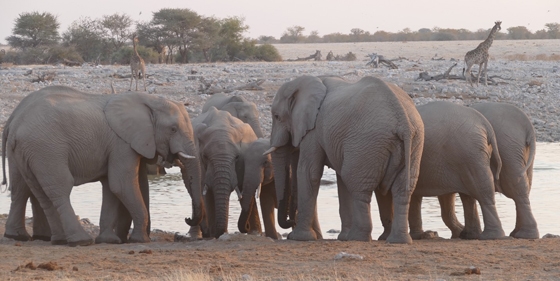
The trip ends in a completely different habitat—the riparian forests of the Caprivi Strip and Botswana’s Okavango Delta. I visited the Okavango Delta on my first trip to Africa over twenty years ago—I was just beginning to bird then and I’m eager to get back to one of the richest bird environments in Africa. A great reason for me to be traveling with GGBA.
Editor’s Note: Due to a recent cancellation, we have two spots available on our GGBA Namibia/Botswana trip that begins on August 25 and ends on September 5. We know it’s short notice, but this is the trip of a lifetime and if your schedule allows…. Also worth noting is that the price we were quoted is in South African Rand, and given currency exchange rates, this trip now costs $400 less than we originally advertised 10 months ago. More information can be found here.
If you have questions about this trip, you can contact Eric Schroeder at ejschroeder@ucdavis.edu.
GGBA Boardmember Eric Schroeder worked at UC Davis where he had a thirty-year career as a lecturer and administrator. His local volunteer work includes serving as president of the Tilden Wildcat Horseman’s Association for seven years and being a member of the East Bay Regional Park District’s Volunteer Mounted Patrol. He recently completed the Master Birder Program sponsored by GGBA and the Academy of Science.
